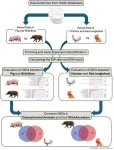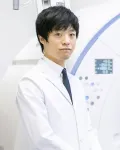(Press-News.org) Eye-tracking allows studying aspects that cannot be seen, for example, the thinking processes of a student solving a mathematical problem. Researchers at Kaunas University of Technology (KTU) are the first in Lithuania to integrate eye-tracking into education and are using the technology to radically improve the teaching of mathematics.
Eye-tracking creates the possibility for researchers to observe a subject’s attention shifts based on where they fix their gaze or how they move it. This helps researchers understand various emotional, thinking and cognitive processes that happen in response to the environment.
“By applying this technology in mathematical education, it is possible to monitor the individual activity of students and see the cognitive processes they undergo when solving mathematical tasks,” says Dr Irina Klizienė, a professor at the KTU Faculty of Social Sciences, Arts and Humanities.
A recent study by Klizienė and her PhD student Asta Paškovskė shows that the research carried out using eye-tracking equipment can indicate the difficulties a child encounters while solving a mathematical problem.
Reveals significant details that go by unnoticed
“Eye-tracking studies with children reveal the strategies they use to process visuals in mathematical tasks, and the gaze patterns identified show the difficulties they experience in each problem-solving step. It is a great advantage to be able to observe the decision-making processes without interfering with their work,” says Prof. Klizienė.
Klizienė and Paškovskė’s systematic literature review analysed the possibilities of applying eye-tracking methodology to identify the strategies used by primary school students to solve mathematical problems. The eye-tracking data reveals which steps of problem-solving are the most challenging or which elements of the task are more difficult to understand. These are important details that usually go unnoticed in mathematics classes as students are not always able to identify them.
“Eye-tracking makes it possible for us to see where a child is focusing their gaze when solving a mathematical problem. It helps to identify which problem-solving steps are the most difficult, how the child selects and processes information, and where the child focuses his or her attention,” says Paškovskė.
By analysing this data, teachers can suggest more effective teaching methods while students can adopt better learning habits.
Provides valuable insights into the learning process
Prof. Klizienė, who researches the impact of the educational environment on students’ achievements in mathematics, says that, compared to other methods, eye-tracking provides essential data on mathematics learning – not only on the results of the learning process. This method provides insights into students’ cognitive processes.
The eye-tracking research uses special non-invasive eye-trackers and software. These devices are not harmful to the human eye and are designed to be used in the subject’s natural environment. They normally consist of three parts: a light source (usually infrared light), a gaze-tracking camera that captures flashes of the visible image reflected in the cornea and the centre of the pupil, and a processor with eye-tracking software.
Eye-tracking research provides information and allows studying cognitive processes that reflect in eye movements and could otherwise not be consciously observed and explained. “Monitoring the mathematical problem-solving process – its strategies, cognitive load, attention span and shifting – is made possible by tracking and recording eye movements, the patterns (consistency, repetition) of task reading, fixations and areas of interest,” says Klizienė.
Could be used to improve mathematical tasks
The use of eye-tracking technology can help to improve student’s academic achievements and make the learning process more productive. Having identified the patterns of task reading, educators can adapt the learning material to make it more understandable.
“By observing where students focus their gaze, we can optimise the layout of the teaching material so that the most important parts of the task are seen first. For example, if a child often skips a certain part of a task, the teaching material can be made to draw their attention to that part,” comments Paškovskė.
The learning process can be personalised by determining the level of cognitive load children experience while solving mathematical tasks and optimising and reducing it. This helps to improve learning efficiency. “Eye-tracking research provides valuable data to improve the learning process, making it more personalised, effective and engaging,” says the KTU PhD student, a co-author of the study.
The researchers claim that research-based assessment of students’ motivation allows them to identify which learning methods encourage students to be more engaged in the learning process. They hope that their research will not only improve the teaching of mathematics but also contribute to improving students’ academic performance and learning experiences.
Eye-tracking technology is becoming an important tool in education, enabling a deeper understanding of the learning processes and the development of more effective teaching methods to improve children’s acquisition of mathematical knowledge and skills.
The insights described above are based on the scientific article “Eye tracking technology on children's mathematical education: systematic review”, published in the scientific journal “Frontiers in Education”, which can be read and downloaded here.
END
KTU researchers’ eye-tracking study provides valuable insights into learning mathematics
Researchers at Kaunas University of Technology (KTU) are the first in Lithuania to integrate eye-tracking into education and are using the technology to radically improve the teaching of mathematics.
2024-08-02
ELSE PRESS RELEASES FROM THIS DATE:
New approaches and insights on the environment and climate change at the 37th International Geological Congress 2024
2024-08-02
□ Overview
○ Event: The 37th International Geological Congress 2024 (IGC 2024)
○ Date/Venue:: 25 Aug (Sun) - 31 Aug (Sat) 2024, 7 days / BEXCO, Busan, Republic of Korea ※ Hosted in a 4-year cycle across continents
○ Scale: Over 7,000 participants from 121 countries (more than 3,000 scientipic programs, 250 exhibition booths)
○ Theme: The Great Travelers: Voyages to the Unifying Earth
○ Host: International Union of Geologcial Sciences (IUGS)
○ Organizer: IGC 2024 Organizing Committee (The Geological Society Of Korea, Korea Institute of Geoscience and Mineral Resources, Busan Metropolitan ...
Genetic signatures of domestication identified in pigs, chickens
2024-08-02
Wild boars and red junglefowl gave rise to common pigs and chickens. These animals’ genes evolved to express themselves differently, leading to signatures of domestication — such as weaker bones and better viral resistance — in pigs and chickens, according to a research team based in Japan.
The findings, published on July 6 in Animals, could provide insight into the genetic changes of the domestication process and highlight target genes for healthier and more productive livestock breeding, the researchers ...
Megamonas bacterium found to influence obesity risk
2024-08-02
A recent study published in Cell Host & Microbe identifies a potential obesity-linked bacterium, Megamonas, from a large-scale cohort of obese individuals in China. This research suggests potential strategies for future obesity management by illustrating how the bacterium degrades intestinal myo-inositol, enhances lipid absorption, and contributes to obesity.
The study is jointly conducted by Ruijin Hospital affiliated with Shanghai Jiao Tong University School of Medicine, BGI Research, and BGI Genomics Institute of Intelligent Medical Research (IIMR).
"Through a large-scale study of intestinal ...
Scientists find a human “fingerprint” in the upper troposphere’s increasing ozone
2024-08-02
Ozone can be an agent of good or harm, depending on where you find it in the atmosphere. Way up in the stratosphere, the colorless gas shields the Earth from the sun’s harsh ultraviolet rays. But closer to the ground, ozone is a harmful air pollutant that can trigger chronic health problems including chest pain, difficulty breathing, and impaired lung function.
And somewhere in between, in the upper troposphere — the layer of the atmosphere just below the stratosphere, where most aircraft cruise — ozone contributes to warming the planet as a potent greenhouse gas.
There are signs that ozone is continuing to rise in the upper troposphere despite efforts to reduce its ...
Researchers develop promising therapy treatment that can kill glioblastoma cells in newly discovered brain pathway
2024-08-02
A new pathway that is used by cancer cells to infiltrate the brain has been discovered by a team of Canadian and American research groups led by the Singh Lab at McMaster University. The research also reveals a new therapy that shows promise in blocking and killing these tumors.
The research, published in Nature Medicine on Aug. 2, 2024, offers new hope and potential treatments for glioblastoma, the most aggressive form of brain cancer. With existing treatments like surgery, radiation therapy and chemotherapy, the tumors often return, and
patient survival is limited to only a few months. With this new treatment, ...
York researchers make breakthrough in bid to develop vaccines and drugs for neglected tropical disease
2024-08-02
Scientists have developed a new, safe and effective way to infect volunteers with the parasite that causes leishmaniasis and measure the body’s immune response, bringing a vaccine for the neglected tropical disease a step closer.
The breakthrough, by a team from the University of York and Hull York Medical School, is described in the journal Nature Medicine and lays the foundations for vaccine development and for testing new preventative measures.
Controlled human infection studies, where volunteers are exposed to small amounts of ...
Combined effects of plastic pollution and seawater flooding amplify threats to coastal plant species
2024-08-02
Two of the planet’s more pressing environmental stressors have the potential to alter the growth and reproductive output of plants found right along the world’s coastlines, a new study suggests.
The research, published in the journal Environmental Pollution, is one of the first to examine the combined effects of seawater flooding and microplastic pollution on coastal plants.
It showed that both stressors had some effects on the species tested, with microplastics impacting the plants’ reproduction while flooding caused greater tissue death.
However, being exposed to both microplastics ...
Sea level changes shaped early life on Earth, fossil study reveals
2024-08-02
A newly developed timeline of early animal fossils reveals a link between sea levels, changes in marine oxygen, and the appearance of the earliest ancestors of present-day animals.
The study reveals clues into the forces that drove the evolution of the earliest organisms, from which all major animal groups descended.
A team from the University of Edinburgh studied a compilation of rocks and fossils from the so-called Ediacaran-Cambrian interval – a slice of time 580–510 million years ago. This period witnessed an explosion of biodiversity according to fossil records, the causes of which have ...
'Screaming Woman' mummy may have died in agony 3,500 years ago
2024-08-02
In 1935, the Metropolitan Museum of New York led an archaeological expedition to Egypt. In Deir Elbahari near Luxor, the site of ancient Thebes, they excavated the tomb of Senmut, the architect and overseer of royal works – and reputedly, lover – of the famed queen Hatschepsut (1479-1458 BCE). Beneath Senmut's tomb, they found a separate burial chamber for his mother Hat-Nufer and other, unidentified relatives.
Here, they made an uncanny discovery: a wooden coffin holding the mummy of an elderly woman, wearing a black wig and two scarab rings in silver and gold. But what struck the archaeologists was the ...
Healthy AI: Sustainable artificial intelligence for healthcare
2024-08-02
Similar to other sectors around the world, the light speed development of artificial intelligence (AI) has made its way into healthcare, particularly the radiology field. As such, AI-based diagnostic systems are flourishing, with hospitals quickly adopting the technology to assist radiologists. In contrast, there are concerns about the environmental impact of increasingly complex AI models and the need for more sustainable AI solutions.
Therefore, Associate Professor Daiju Ueda of Osaka Metropolitan University’s ...
LAST 30 PRESS RELEASES:
Longest observation of an active solar region
Why nail-biting, procrastination and other self-sabotaging behaviors are rooted in survival instincts
Regional variations in mechanical properties of porcine leptomeninges
Artificial empathy in therapy and healthcare: advancements in interpersonal interaction technologies
Why some brains switch gears more efficiently than others
UVA’s Jundong Li wins ICDM’S 2025 Tao Li Award for data mining, machine learning
UVA’s low-power, high-performance computer power player Mircea Stan earns National Academy of Inventors fellowship
Not playing by the rules: USU researcher explores filamentous algae dynamics in rivers
Do our body clocks influence our risk of dementia?
Anthropologists offer new evidence of bipedalism in long-debated fossil discovery
Safer receipt paper from wood
Dosage-sensitive genes suggest no whole-genome duplications in ancestral angiosperm
First ancient human herpesvirus genomes document their deep history with humans
Why Some Bacteria Survive Antibiotics and How to Stop Them - New study reveals that bacteria can survive antibiotic treatment through two fundamentally different “shutdown modes”
UCLA study links scar healing to dangerous placenta condition
CHANGE-seq-BE finds off-target changes in the genome from base editors
The Journal of Nuclear Medicine Ahead-of-Print Tip Sheet: January 2, 2026
Delayed or absent first dose of measles, mumps, and rubella vaccination
Trends in US preterm birth rates by household income and race and ethnicity
Study identifies potential biomarker linked to progression and brain inflammation in multiple sclerosis
Many mothers in Norway do not show up for postnatal check-ups
Researchers want to find out why quick clay is so unstable
Superradiant spins show teamwork at the quantum scale
Cleveland Clinic Research links tumor bacteria to immunotherapy resistance in head and neck cancer
First Editorial of 2026: Resisting AI slop
Joint ground- and space-based observations reveal Saturn-mass rogue planet
Inheritable genetic variant offers protection against blood cancer risk and progression
Pigs settled Pacific islands alongside early human voyagers
A Coral reef’s daily pulse reshapes microbes in surrounding waters
EAST Tokamak experiments exceed plasma density limit, offering new approach to fusion ignition
[Press-News.org] KTU researchers’ eye-tracking study provides valuable insights into learning mathematicsResearchers at Kaunas University of Technology (KTU) are the first in Lithuania to integrate eye-tracking into education and are using the technology to radically improve the teaching of mathematics.






